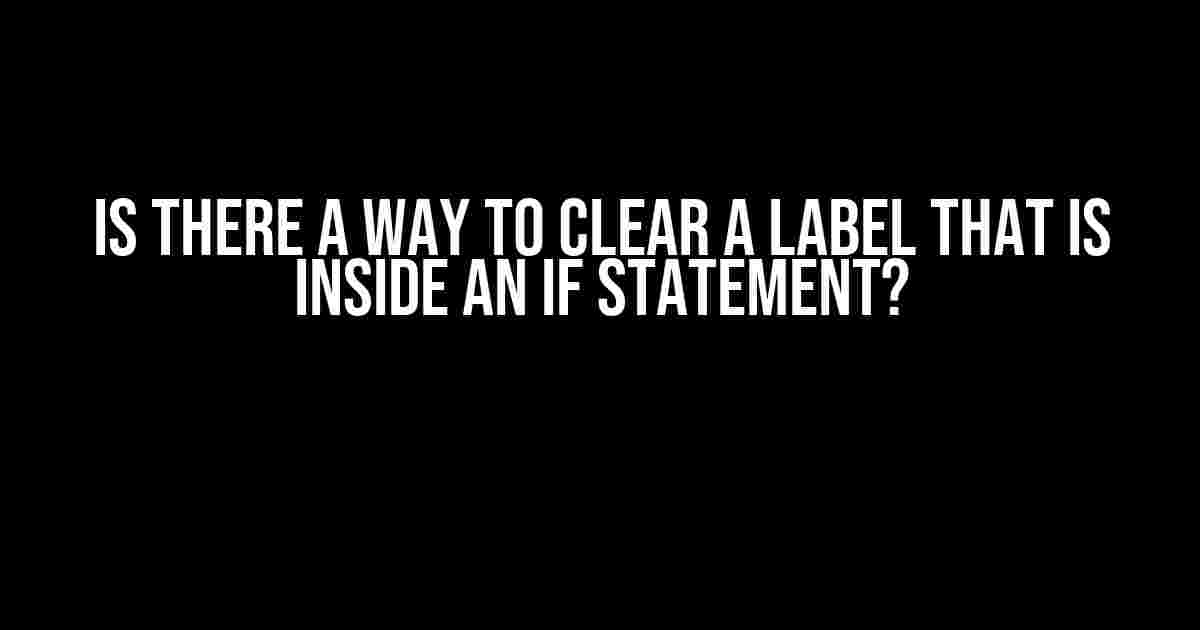Ah, the age-old conundrum that has puzzled developers for centuries! Okay, maybe not centuries, but it’s definitely a common problem that can leave even the most seasoned coders scratching their heads. So, is there a way to clear a label that is inside an IF statement? The short answer is yes, and in this article, we’ll explore the various ways to do just that.
The Issue: Labels Inside IF Statements
Before we dive into the solutions, let’s first understand the problem. When you have a label inside an IF statement, it can be tricky to clear the label’s text or value because the label is tied to the condition of the IF statement. This means that the label’s text or value is only accessible within the scope of the IF statement.
if (condition) {
label.text = "Some text";
}
In the example above, the label’s text is set to “Some text” only if the condition is true. But what if you want to clear the label’s text or value outside of the IF statement? That’s where things get tricky.
Solution 1: Using a Global Variable
One way to clear a label that is inside an IF statement is to use a global variable. By declaring a global variable outside of the IF statement, you can access and modify the label’s text or value from anywhere in your code.
var labelText = "";
if (condition) {
labelText = "Some text";
label.text = labelText;
}
// Clear the label's text
labelText = "";
label.text = labelText;
In this example, we declare a global variable `labelText` and set it to an empty string. Then, inside the IF statement, we set the label’s text to `labelText`. Finally, outside of the IF statement, we can clear the label’s text by setting `labelText` to an empty string and updating the label’s text again.
Solution 2: Using a Function
Another way to clear a label that is inside an IF statement is to use a function. By wrapping the label’s text or value in a function, you can call the function from anywhere in your code to clear the label.
function setLabelText(text) {
label.text = text;
}
if (condition) {
setLabelText("Some text");
}
// Clear the label's text
setLabelText("");
In this example, we define a function `setLabelText` that takes a `text` parameter and sets the label’s text to that value. Inside the IF statement, we call the function with the desired text. Then, outside of the IF statement, we can clear the label’s text by calling the function with an empty string.
Solution 3: Using a Separate Label for Error Messages
Sometimes, the label inside the IF statement is used to display error messages or validation errors. In this case, you can use a separate label specifically for error messages, making it easier to clear the label’s text or value.
if (condition) {
errorLabel.text = "Error message";
}
// Clear the error label's text
errorLabel.text = "";
In this example, we use a separate label `errorLabel` to display error messages. When the condition is true, we set the error label’s text to the error message. Then, outside of the IF statement, we can clear the error label’s text by setting it to an empty string.
Solution 4: Using a Data Binding Framework
If you’re working with a data binding framework like Knockout.js or Angular.js, you can use the framework’s built-in features to clear the label’s text or value.
// Knockout.js example
var viewModel = {
labelText: ko.observable("")
};
if (condition) {
viewModel.labelText("Some text");
}
// Clear the label's text
viewModel.labelText("");
In this example, we use Knockout.js to create an observable variable `labelText` and bind it to the label’s text. Inside the IF statement, we set the `labelText` observable to the desired value. Then, outside of the IF statement, we can clear the label’s text by setting the `labelText` observable to an empty string.
Best Practices
When working with labels inside IF statements, here are some best practices to keep in mind:
- Use a consistent naming convention for your labels and variables.
- Keep your IF statements simple and easy to read.
- Avoid nesting IF statements whenever possible.
- Use functions or global variables to make your code more modular and reusable.
- Consider using a data binding framework to simplify your code and make it more maintainable.
Conclusion
Clearing a label that is inside an IF statement can be a challenging task, but with the right techniques, it’s definitely possible. By using a global variable, a function, a separate label for error messages, or a data binding framework, you can easily clear the label’s text or value and make your code more readable and maintainable. Remember to follow best practices and keep your code simple, modular, and easy to understand.
| Solution | Description |
|---|---|
| Global Variable | Use a global variable to store the label’s text or value and access it from anywhere in your code. |
| Function | Wrap the label’s text or value in a function and call it from anywhere in your code to clear the label. |
| Separate Label for Error Messages | Use a separate label specifically for error messages, making it easier to clear the label’s text or value. |
| Data Binding Framework | Use a data binding framework like Knockout.js or Angular.js to bind the label’s text or value to an observable variable. |
By following these solutions and best practices, you’ll be able to clear labels inside IF statements with ease and write more efficient, readable, and maintainable code.
- What is the most common use case for labels inside IF statements?
- How do you typically handle error messages in your code?
- Have you ever encountered a situation where you needed to clear a label inside an IF statement?
- What is your preferred method for clearing labels inside IF statements?
- Do you have any other questions or concerns about clearing labels inside IF statements?
Frequently Asked Question
Get the inside scoop on clearing labels inside if statements!
Can I clear a label that is inside an if statement using a simple assignment?
Unfortunately, no. You can’t simply assign a null value to the label to clear it. The label will persist until the if statement is re-evaluated. But don’t worry, there are other ways to clear that label!
How do I clear a label inside an if statement using JavaScript?
You can use JavaScript to remove the label by setting the innerHTML of its parent element to an empty string. For example: `document.getElementById(“parentElement”).innerHTML = “”;`. This will remove the label and any other content inside the parent element.
What if I want to clear a label inside an if statement in Python?
In Python, you can clear a label by setting its text property to an empty string. For example: `my_label.config(text=””)`. This will remove the text from the label, effectively clearing it.
Is there a way to clear a label inside an if statement in C#?
Yes, in C#, you can clear a label by setting its Text property to an empty string. For example: `myLabel.Text = string.Empty;`. This will remove the text from the label, clearing it.
Can I clear a label inside an if statement using a framework like React or Angular?
Yes, in frameworks like React or Angular, you can clear a label by updating the component’s state or using a template binding to set the label’s text to an empty string. For example, in React, you can use `this.setState({ labelValue: “” });` to clear the label.



